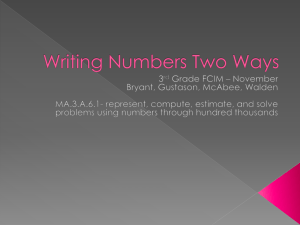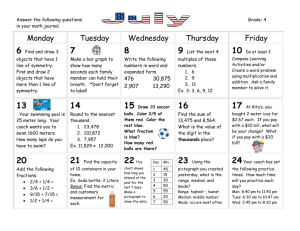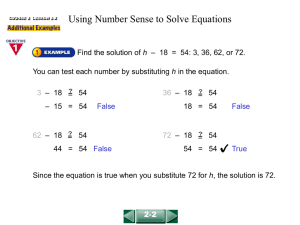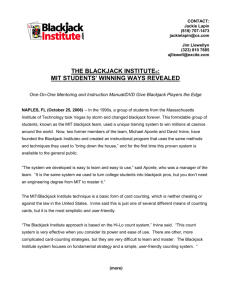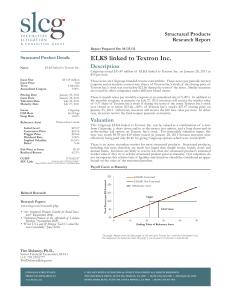Basic Concepts, Interpretation of Probability
advertisement
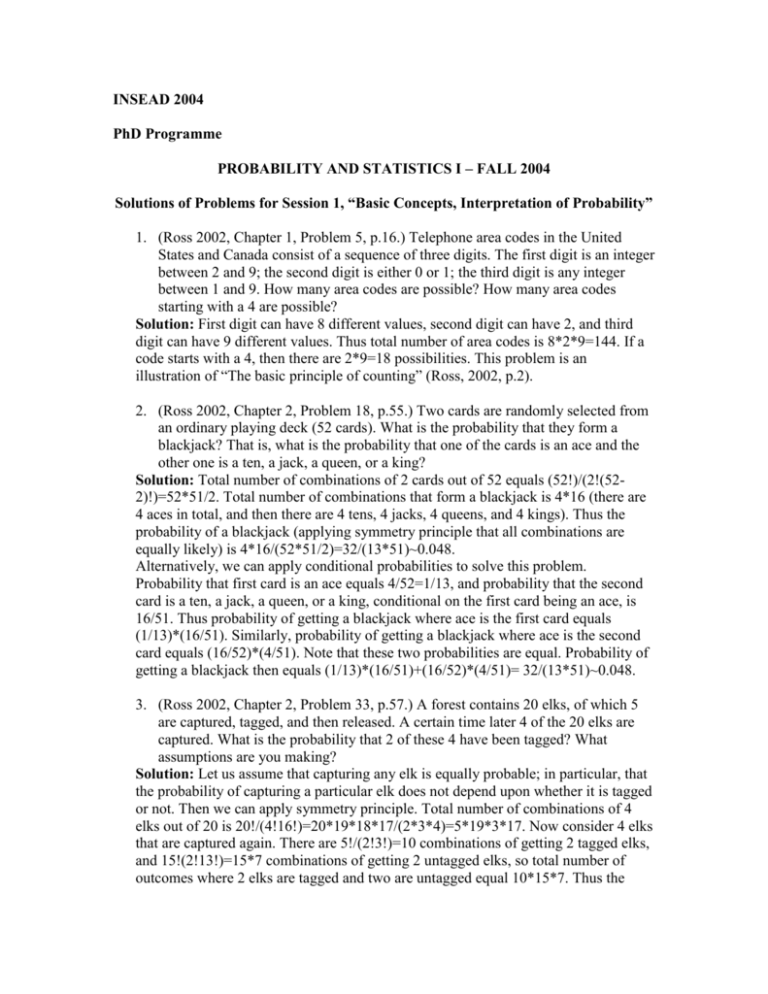
INSEAD 2004 PhD Programme PROBABILITY AND STATISTICS I – FALL 2004 Solutions of Problems for Session 1, “Basic Concepts, Interpretation of Probability” 1. (Ross 2002, Chapter 1, Problem 5, p.16.) Telephone area codes in the United States and Canada consist of a sequence of three digits. The first digit is an integer between 2 and 9; the second digit is either 0 or 1; the third digit is any integer between 1 and 9. How many area codes are possible? How many area codes starting with a 4 are possible? Solution: First digit can have 8 different values, second digit can have 2, and third digit can have 9 different values. Thus total number of area codes is 8*2*9=144. If a code starts with a 4, then there are 2*9=18 possibilities. This problem is an illustration of “The basic principle of counting” (Ross, 2002, p.2). 2. (Ross 2002, Chapter 2, Problem 18, p.55.) Two cards are randomly selected from an ordinary playing deck (52 cards). What is the probability that they form a blackjack? That is, what is the probability that one of the cards is an ace and the other one is a ten, a jack, a queen, or a king? Solution: Total number of combinations of 2 cards out of 52 equals (52!)/(2!(522)!)=52*51/2. Total number of combinations that form a blackjack is 4*16 (there are 4 aces in total, and then there are 4 tens, 4 jacks, 4 queens, and 4 kings). Thus the probability of a blackjack (applying symmetry principle that all combinations are equally likely) is 4*16/(52*51/2)=32/(13*51)~0.048. Alternatively, we can apply conditional probabilities to solve this problem. Probability that first card is an ace equals 4/52=1/13, and probability that the second card is a ten, a jack, a queen, or a king, conditional on the first card being an ace, is 16/51. Thus probability of getting a blackjack where ace is the first card equals (1/13)*(16/51). Similarly, probability of getting a blackjack where ace is the second card equals (16/52)*(4/51). Note that these two probabilities are equal. Probability of getting a blackjack then equals (1/13)*(16/51)+(16/52)*(4/51)= 32/(13*51)~0.048. 3. (Ross 2002, Chapter 2, Problem 33, p.57.) A forest contains 20 elks, of which 5 are captured, tagged, and then released. A certain time later 4 of the 20 elks are captured. What is the probability that 2 of these 4 have been tagged? What assumptions are you making? Solution: Let us assume that capturing any elk is equally probable; in particular, that the probability of capturing a particular elk does not depend upon whether it is tagged or not. Then we can apply symmetry principle. Total number of combinations of 4 elks out of 20 is 20!/(4!16!)=20*19*18*17/(2*3*4)=5*19*3*17. Now consider 4 elks that are captured again. There are 5!/(2!3!)=10 combinations of getting 2 tagged elks, and 15!(2!13!)=15*7 combinations of getting 2 untagged elks, so total number of outcomes where 2 elks are tagged and two are untagged equal 10*15*7. Thus the desired probability is (10*15*7)/(5*19*3*17)=(10*7)/(19*17)=70/323~0.217. Note that the assumption that capturing each elk is equally probably is very crucial. For instance, if some elks are slow and thus easier to capture, then it would be easier to capture a tagged elk than an untagged elk. 4. A missile hits (and if it hits, it destroys) the target with probability 0.9 (so the probability that it misses the target is 0.1). We have 10 missiles to destroy the target. What is the probability that we will destroy it? Hint: consider the probability that we do not destroy it after shooting all 10 missiles. Solution: Probability that all 10 missiles do not destroy the target equals 10-10. Thus the probability that we destroy the target equals 1-10-10. 5. There is a joke: “Long time ago people believed that if 1,000,000 monkeys sit in front of typewriters, eventually they will type Hamlet (or some other thoughtful novel). Development of internet has shown that this is not the case.” Let us consider the probability of generating one page that matches the first page of Hamlet. Suppose there are 2,000 characters on this page, and there are 26 possible characters (so we ignore punctuation marks and capital letters). When a monkey types, all characters are equally likely. a) What is the probability that a sequence of 2,000 characters will match the first page of Hamlet? b) How many trials should we make (e.g., how many monkeys, assuming that each monkey types only one page, should we have) in order to generate Hamlet’s first page with probability 0.8? Solution: a) There are 262000 different first pages. Since all of 2000 characters are equally likely and independent, probability that a randomly drawn sequence matches the first page is 26-2000. Note that log10(26)~1.4, so 26-2000~10-28000, which is minuscule. b) Similar to problem 4 above, consider the probability that N monkeys (trials) do not generate a sequence that matches the first page. For 1 monkey this probability is (1-26-2000), and for N monkeys it is (1-26-2000)N. As one would expect, this probability decreases with N. The desired N is given by the solution of the equation (1-26-2000)N=10.8. Recall that, by first-order Taylor expansion, (1-x)a=1-ax+o(x), where limx0(o(x)/x)=0. Applying this, we get is (1-26-2000)N1-N26-2000=1-0.8, so N=0.8*262000~0.8*1028000.




